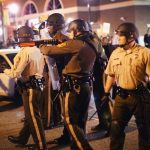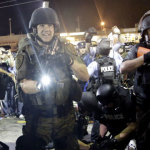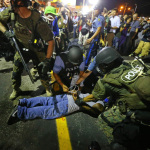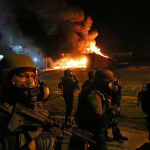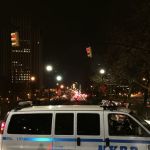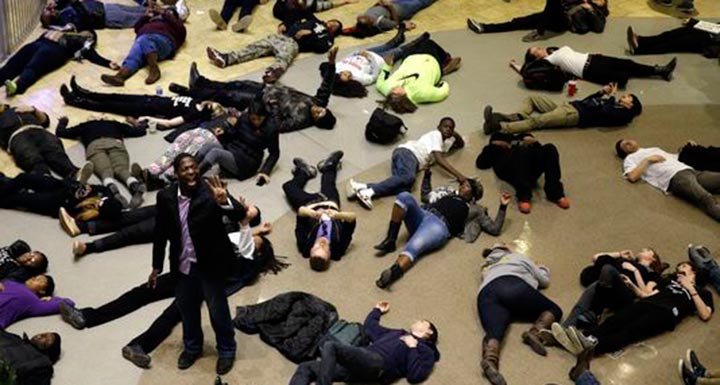
Ferguson a defining moment for race relations in USA
FERGUSON, Mo.— When it comes to combating racial inequality, Cat Daniels says her generation has failed their children.
Daniels, 53, has tried to do her part righting that wrong by cooking and serving as the hen mother for countless young people on the front lines of the protest movement that blossomed here after the shooting death of an unarmed black teenager in August.
“This is 2014, and we are still confronting the problems that our mothers and fathers confronted back in the civil rights era,” said Daniels, who is affectionately called Mama Cat by the protesters. “My generation came along, and we fed off what they did. We didn’t fight and keep the fight going. Now, because we didn’t keep the fight, our children have to fight.”
The anger in the African-American community over a grand jury’s decision last week not to indict Darren Wilson, the white police officer who killed 18-year-old Michael Brown, hasn’t subsided.
This suburb of 20,000 near St. Louis is still reeling after rioters looted and burned down more than businesses after the grand jury decision. The state of emergency declaration issued by Gov. Jay Nixon ahead of the grand jury announcement remains firmly in place.
Although the wounds are still fresh, the activists at ground zero of the Ferguson movement say they are dedicated to making certain Brown’s death — and the decision not to charge Wilson — marks just the beginning of a thorough self-examination about race in America.
Over the Thanksgiving weekend, protesters throughout the country flooded malls and big chain stores to call on Americans to boycott shopping as a sign of solidarity with the cause.
Activists for ‘justice’
On Saturday, NAACP members began a 120-mile walk that will take them from Brown’s neighborhood to the governor’s mansion in Jefferson City. The point of the effort is to draw attention to activists’ calls for a change in leadership in the Ferguson Police Department and broad reforms in how police departments across the country conduct themselves.
For many young adults and teens, Ferguson has become no less than a seminal event that has opened their eyes about the state of race relations in America.
Avery Gales, 14, who regularly took part in the protests the past three months, said that his previous interactions with police consisted of him getting shooed away by officers when he would use buckets as drums and beat on them near an expressway entrance to try to hustle change from passing motorists.
Brown’s killing only hardened his views.
“This made me want to fight for justice,” Avery said, “When I heard about Mike Brown, I thought … he could be out there playing the drums. They say he died before his graduation. I just don’t want to be like that — have police shoot me before my graduation.”
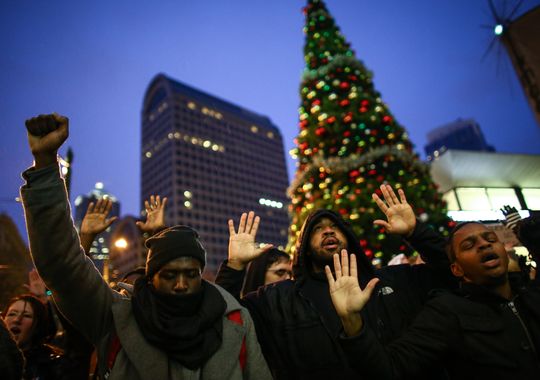 Racial divide over Ferguson
Racial divide over Ferguson
The country certainly remains deeply divided about what went down in Ferguson. A Huffington Post-YouGov poll of 1,000 adults released last week found that 62% of African Americans believed Wilson was at fault in the shooting of Brown. Only 22% of whites believed Wilson was at fault.
The chasm of opinion is hardly surprising to analysts and academics who study race.
Keisha Bentley-Edwards, a University of Texas-Austin professor whose research has focused on the racial experience of youth, noted several high-profile killings of unarmed black men and women (Eric Garner in New York, John Crawford in Ohio and Renisha McBride in Detroit) have led to an accumulated outrage.
“This decision does not stand alone,” Bently-Edwards said of the grand jury’s decision not to indict Wilson. “The reality is for a lot of African Americans, they don’t need to see statistics to know that they are being targeted. They know they are being stopped multiple times and that this is not the reality for white Americans.”
The divide goes beyond the issue of police brutality. In a 2013 Gallup poll about affirmative action, 22% of whites said race should be considered to promote diversity on college campuses, while 48% of blacks and 31% of Hispanics believed race should be taken into account.
Some whites who are angry about Brown’s killing and St. Louis County prosecutor Robert McCulloch’s handling of the case acknowledged an initial reluctance to be too outspoken about the case.
Jennifer Rogers, 45, a white woman from Richmond Heights, Mo., seethed for months about many aspects of the case, including Ferguson police letting Brown’s body sit out in the street for more than four hours after he was killed and Nixon declining to name a special prosecutor to oversee the case.
“I felt like I had to stand back and not say anything, because I’m not a young black man,” said Rogers, who took part in Black Friday protests. “Since this happened, I’ve thought a lot about it. I came to the conclusion that if I don’t say something and I don’t stand up for what I think is wrong in the system then nothing is going to change.”
Long, winding road
The road to racial understanding may be as winding as the problems affecting Ferguson and the country long before Brown’s death, said Jay Daniels, 27, of Charlotte.
Even in Ferguson, some protesters said there were disparate groups with differing messages that made it difficult to get everybody on the same page, as has happened with the Occupy Wall Street protest movement that began in 2011 against social and economic inequality worldwide.
On Friday night in Ferguson, 16 people were arrested outside the police station who had come from Boycott Black Friday protests at stories in the area, and 15 of them were not from Missouri.
Daniels says Wilson not being indicted sends a clear message that black life in America doesn’t carry the same value as white life. He called the grand jury’s decision “blatant disrespect” and said the criminal justice’s unfair treatment of blacks must be examined.
As he stood among hundreds of protesters at the Ferguson police station last week, Daniels shared an ominous message.
“Some people are going to have to die for the cause,” the financial consultant said. “It’s sad to say, but this is the new civil rights movement for our generation, and there will be casualties and there should be bloodshed.”
(From the: USA TODAY)

